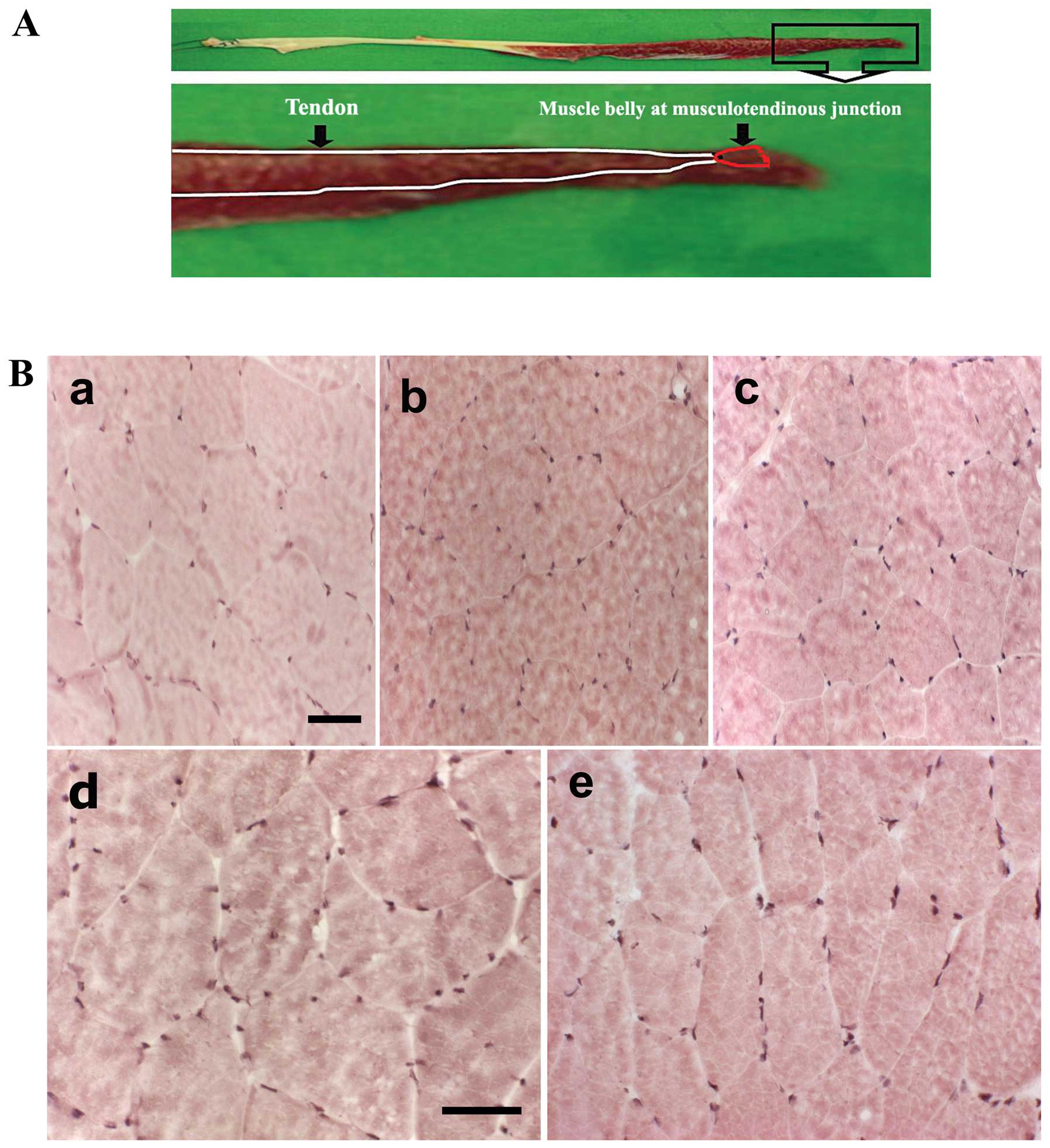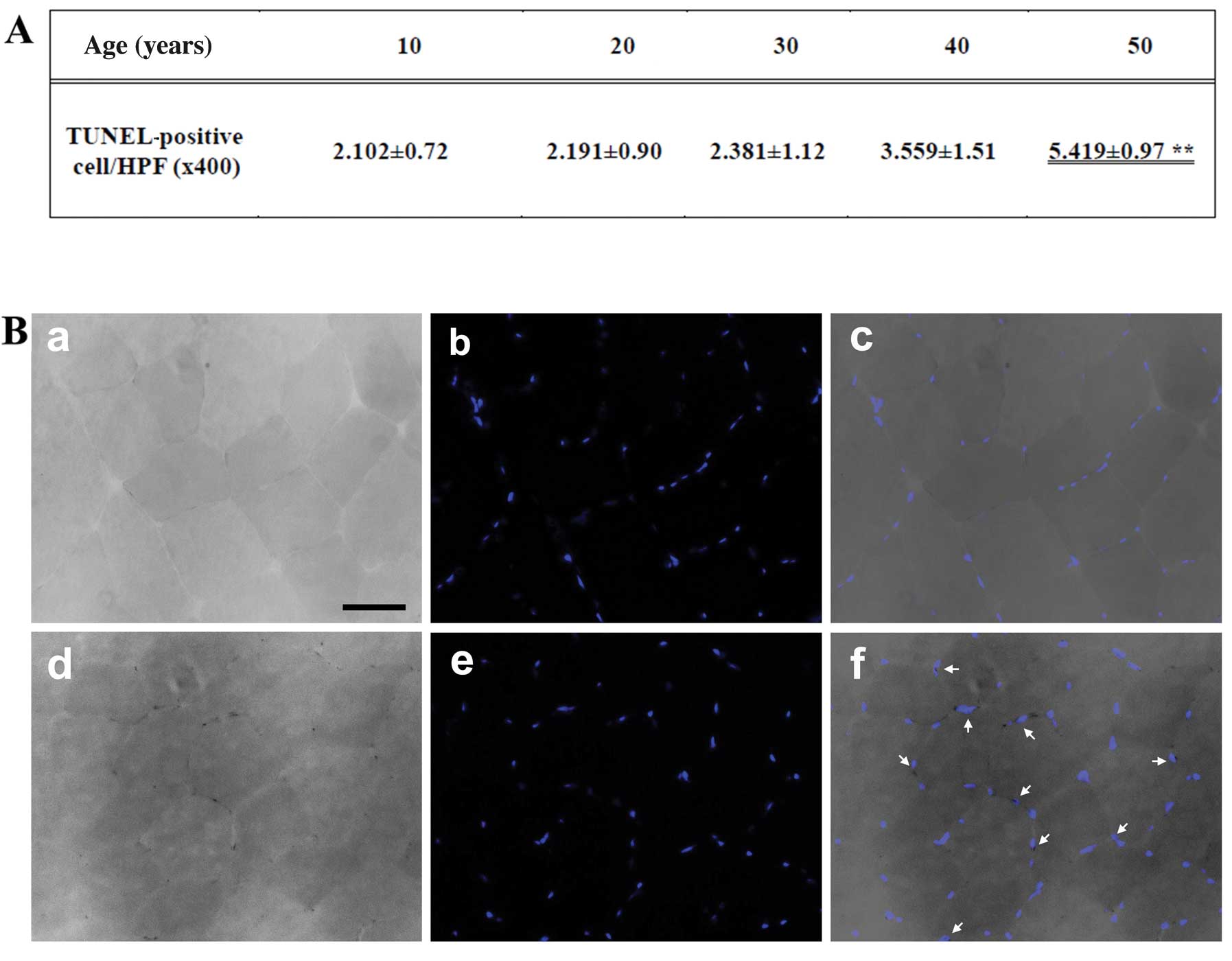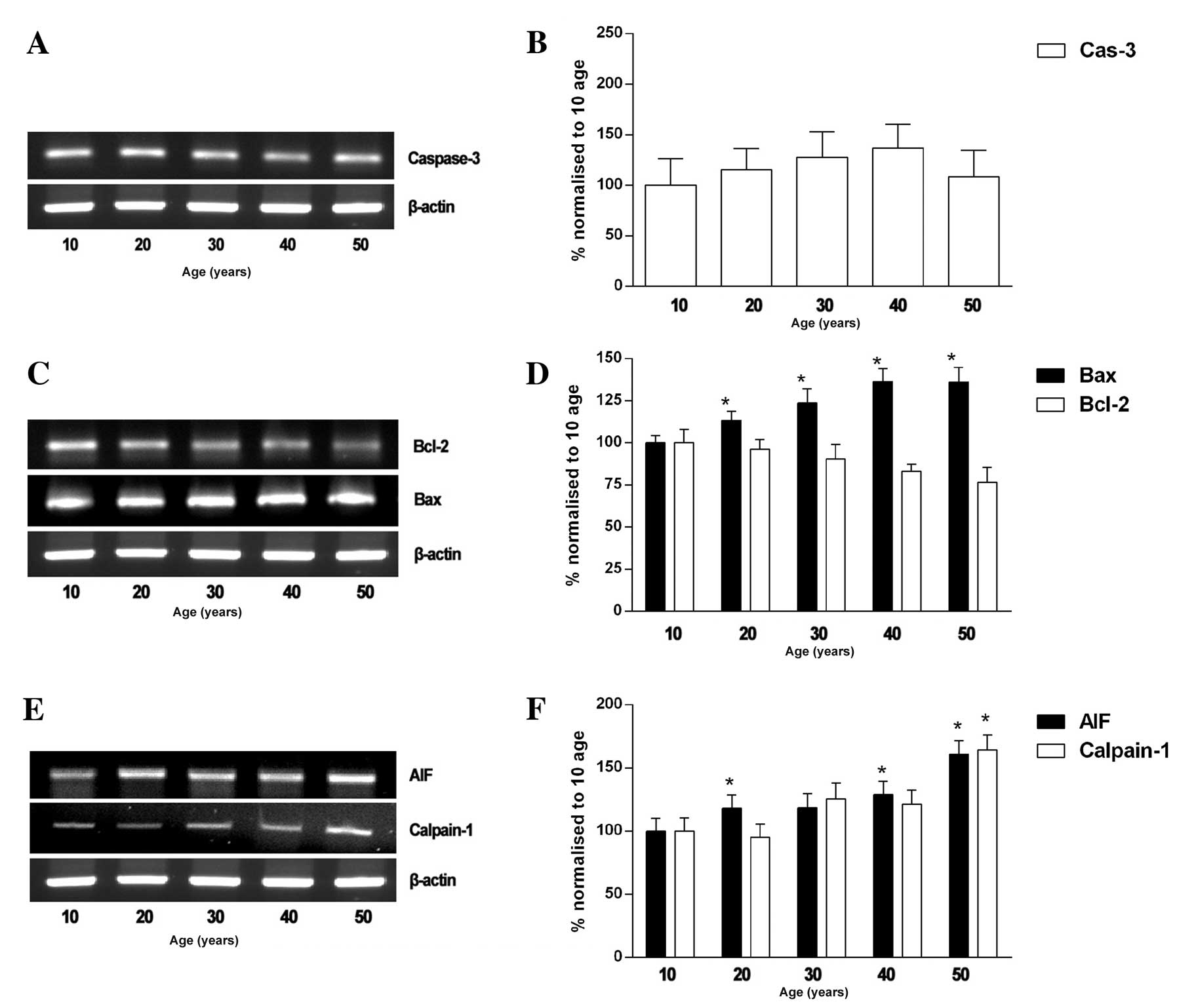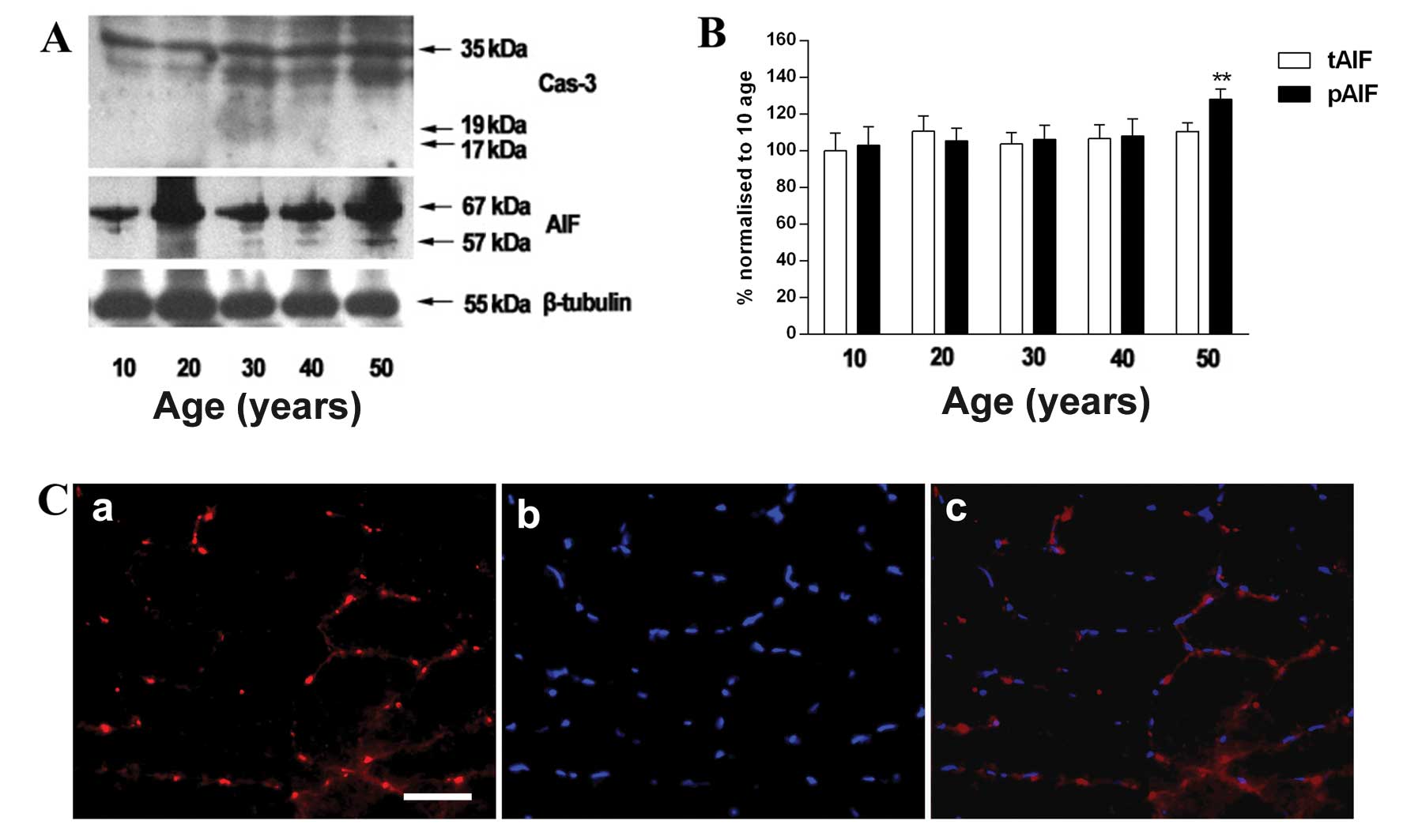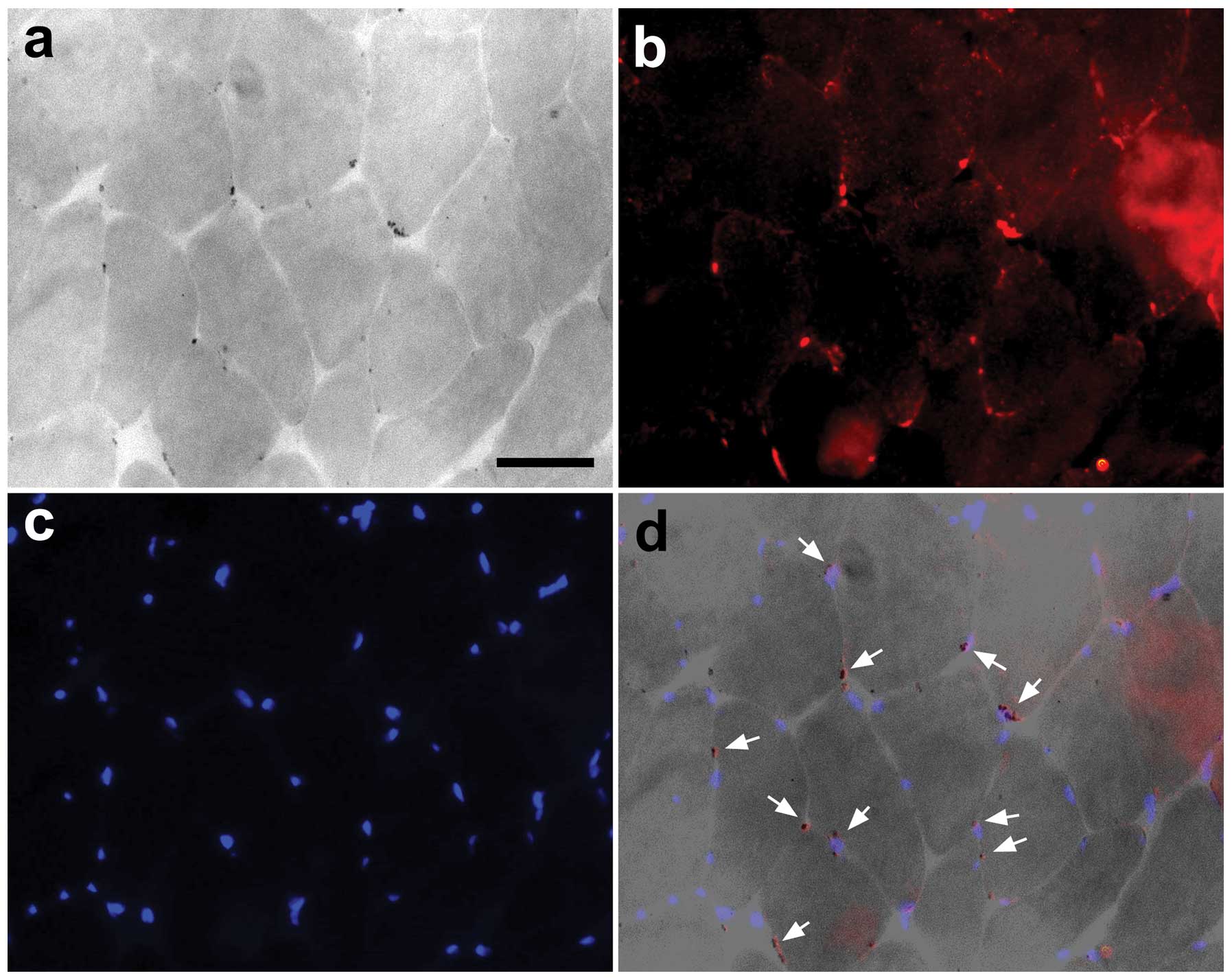Differential expression of apoptosis-related factors induces the age-related apoptosis of the gracilis muscle in humans
- Authors:
- Published online on: February 27, 2014 https://doi.org/10.3892/ijmm.2014.1675
- Pages: 1110-1116
-
Copyright: © Park et al. This is an open access article distributed under the terms of Creative Commons Attribution License [CC BY_NC 3.0].
Abstract
Introduction
Human skeletal muscle is often injured physically or chemically and changes occur with aging and disease. The age-related loss of muscle mass, strength and quality, referred to as sarcopenia, is a common feature of aging that is characterized by a decline in both the number and size of muscle fibers (1–3). With these age-related changes, the estimated rate of muscle loss is 1–2% per year after the age of 50 years (4,5). The loss of muscle mass due to apoptosis with normal aging has been investigated in a number of studies (6,7).
Apoptosis, a process of individual cell death regulated by the activation of specific genes, is an important regulatory process that occurs during normal development and in the progression of specific diseases (8). Although apoptosis may occur via several mechanisms (9,10), one mechanism involves external factors that bind to membrane death receptors outside the cell, and another involves internal cellular events that lead to the release of specific cell death molecules from the mitochondria (11–13). In the mitochondrial-mediated pathway, in response to cellular stress or DNA damage, p53 can induce apoptosis by regulating the proteins of the Bcl-2 family and by translocating to the mitochondria and activating apoptotic signaling directly (14–16). In addition, caspase-3 can activate caspase-activated DNase, leading to DNA fragmentation and cell death (17). Caspase-independent mechanisms also exist, such as the release of apoptosis-inducing factor (AIF) and endonuclease G (EndoG) from the mitochondria, inducing large-scale DNA fragmentation (18–21).
The release of apoptosis-inducing factors by the mitochondria, nuclear translocation and DNA agmentation associated with AIF have been demonstrated in several systems and cell types. AIF is translocated to the nucleus after being released from the mitochondria, inducing DNA fragmentation (22–24). AIF is found in several human tissues, including cardiac and skeletal muscle (25,26). In addition, the calcium-dependent proteinase (calpain) system is present in every vertebrate cell. At least 3 calpains exist in humans: calpain-1 (μ-calpain), calpain-2 (m-calpain) and calpain-3 (n-calpain, p94) (27,28). A number of studies have demonstrated that the AIF and EndoG pro-apoptotic factors, which are released from the mitochondria by calpain activity, are upregulated in sarcopenic muscle (29–32). However, whether this causes the apoptosis that occurs with the normal aging process in human muscle is not known. Previously, we reported the age-dependent induction of AIF in the human semitendinosus skeletal muscle (33). The aim of the present study was to investigate the general pattern of skeletal muscle apoptosis, particularly in the human gracilis skeletal muscle with extended age (up to 50 years old). We examined the expression of apoptosis-related factors to elucidate the key players associated with the aging-related process in muscles from 10- and 50-year-old individuals.
Materials and methods
Muscle sampling
Samples of gracilis skeletal muscle were collected from individuals of different ages (10, 20, 30, 40 and 50 years old) who underwent anterior cruciate ligament reconstruction with gracilis. Muscles were harvested from individuals of 10 to 50 years of age and 8 samples were analyzed in each age group. All the human subjects were healthy with no muscle-related clinical conditions. Muscle tissues were prepared from the musculotendinous junction, mounted, immediately frozen in liquid nitrogen and stored at −80ºC for immunohistochemical and biochemical analyses. Ethical consent was obtained from the Kyung Hee Medical Center Institutional Review Board.
Histological analysis
Different human gracilis skeletal muscle tissues (n=8 per age group) were fixed in 4% paraformaldehyde, embedded in optimum cutting temperature (OCT) compound, divided into 15-μm-thick sections and stained with hematoxylin and eosin (H&E).
In situ terminal deoxynucleotidyl transferase-mediated dUTP nick end-labeling (TUNEL)
TUNEL assays were performed to detect DNA strand breaks using a commercial kit following the instructions provided by the manufacturer (Chemicon International, Temecula, CA, USA). Briefly, 15-μm-thick sections of skeletal muscle (n=8 per age group) were mounted onto Silane-coated glass slides. The dehydrated sections were treated with 20 μg/ml DNase-free proteinase K (Sigma-Aldrich Corp., St. Louis, MO, USA) to retrieve antigenic epitopes, followed by 3% H2O2 to quench endogenous peroxidase activity. Free 3′-OH termini were labeled with digoxigenin-dUTP for 1 h at 37ºC utilizing a terminal deoxynucleotidyl transferase reaction mixture. The incorporated digoxigenin-conjugated nucleotides were detected using a horseradish peroxidase-conjugated anti-digoxigenin antibody and 3,3′-diaminobenzidine. The dehydrated sections were cleared in xylene, mounted with Canada balsam and enclosed with coverslips.
Immunohistochemistry
Sections (15-μm-thick) of frozen muscle tissue (n=8 per age group) were mounted onto Silane-coated glass slides and fixed in 4% paraformaldehyde (Sigma-Aldrich Corp.) for 1 h at 4ºC and endogenous peroxidase activity was blocked by the immersion of the sections in 3% H2O2 in 100% methanol for 15 min. All samples were incubated in 10% normal donkey serum (NDS) in phosphate-buffered saline (PBS) for 1 h at room temperature and were incubated with antibodies AIF (diluted 1:100; Cell Signaling Technology, Inc., Danvers, MA, USA). Immunohistochemical procedures used antibodies from several sources to establish antibody specificity and confirm immunostaining and protein expression. Primary antibody binding was visualized using Cy3-labeled donkey anti-rabbit antibody (1:500; Jackson ImmunoResearch Inc., West Grove, PA, USA). After staining, the sections were mounted with mounting medium with DAPI.
Extraction of total RNA and reverse transcriptase PCR
Frozen gracilis skeletal muscle was homogenized on ice in 1 ml of ice-cold TRIzol reagent (Invitrogen Corp., Carlsbad, CA, USA). First-strand cDNA synthesis with 5 μg of total RNA was performed using MMLV reverse transcriptase and oligo(dT) primers for 1 h at 42ºC. Subsequently, the PCR amplification was performed by a modified method originally described in the study by Saiki et al (34). Total RNA was solubilized in RNase-free H2O and quantified twice by measuring the optical density (OD) at 260 nm. cDNA was synthesized from 2 g of total RNA, and reverse transcription (Promega Corp., Madison, WI, USA) was performed at 42ºC for 1 h following incubation at 95ºC for 5 min. cDNA amplification was carried out according to the following procedure: 95ºC for 1 min, 56ºC (β-actin), 58ºC (AIF, caspase-3, Bacl-2, Bax and calpain-1) for 1 min, 72ºC for 1 min. Twenty-six to 40 cycles were run, and the reaction was prolonged for 10 min at 72ºC. The sequences of the primers used for PCR were as follows: AIF forward, 5′-AGACGATCCCAAA TAATGCAG-3′ and reverse, 5′-TAGCTCTAGGTGAG TCTTGG-3′; caspase-3 forward, 5′-CGAAATTCAAA GGATGGCTCCTGGTT-3′ and reverse, 5′-CGGTTAA CCCGGGTAAGAAATGTGCAT-3′; Bcl-2 forward, 5′-GCA CGCTGGGAGAAAGGGTACGAT-3′ and reverse, 5′-CACA TCTCCAGCATCCCACTCGTA-3′; Bax forward, 5′-TGCC TCAGGATGCGTCCACCAA-3′ and reverse, 5′-CGGC AATCATCCTCTGCATGCTCCAT-3′; calpain-1 forward, 5′-CATGGTGCTGACCAAGATGAAGGAGAT-3′ and reverse, 5′-GCGCAGCCGCCTCACGGCTCCCAGCCT GTT-3′; and β-actin forward, 5′-TCATGAGTGTGACG TTGACATCCGT-3′ and reverse, 5′-CCTAGAAGCATTT GCGGTGCACGATG-3′. The PCR products were separated on 1.5% agarose gels, visualized by ethidium bromide staining using the i-MAX gel image analysis system (CoreBioSystem, Seoul, Korea), and analyzed using Alpha Ease™ FC software (Alpha Innotech Corp., San Leandro, CA, USA).
Western blot analysis
Western blot analyses were performed to detect AIF and caspase-3 expression on muscle tissue (n=8). Muscle samples were placed in loading buffer, boiled for 5 min and centrifuged. Following quantification, the supernatants were loaded on a 10% sodium dodecylsulfate-polyacrylamide gel and subjected to electrophoresis. The fractionated proteins were transferred onto a polyvinylidene fluoride (PVDF) membranes (Milipore, Billerica, MA, USA), and the membranes, after blocking in 10% non-fat dry milk in TPBS buffer for 1 h at room temperature, were incubated with the primary antibodies to AIF (diluted 1:1,000), caspase-3 (diluted 1:1,000) and β-tubulin (diluted 1:1,000) (all from Cell Signaling Technology, Inc.) and then for 2 h with horseradish peroxidase-conjugated secondary antibodies (1:500; Jackson ImmunoResearch Inc.). After intervening washes, the membranes were developed with the ECL western blotting detection system (Thermo Fisher Scientific, Inc., Waltham, MA, USA) and the resulting chemilumnescence was exposed to film (Agfa HealthCare, Greenville, SC, USA). A tonsil served as a positive control.
Statistical analysis
Statistical analysis was performed using GraphPrism 4.0.3 software (GraphPad Software, Inc., San Diego, CA, USA). All data are presented as the means ± standard deviation (SD) and a Student’s t-test was used to compare group means. AIF antibody and TUNEL assay were observed under a light microscope at magnification (×400). Images were captured using a Zeiss fluorescent microscope and myofibers were counted and measured using Axiovision 4 software (Carl Zeiss MicroImaging GmbH, Jena, Germany).
Results
Muscle sampling and histological analysis
Samples of gracilis skeletal muscle were collected from the musculotendinous junction of different individuals (Fig. 1A). We used H&E staining to examine the morphological changes induced by apoptosis from aging in human gracilis skeletal muscle (Fig. 1B). The detection of large numbers of nuclei is a distinct feature of necrosis. With H&E staining, none of the tissues showed evidence of necrosis.
Detection of apoptosis
We performed TUNEL staining of the gracilis muscle sections. The size (mm2) of each area containing TUNEL-positive cells and the distance from the border of the infarction core were measured with a microruler under ×200 magnification. The number of apoptotic cells was counted in 3 high-power fields (HPF; ×400) under a light microscope, and the mean was recorded as cells/HPF (Fig. 2A). The number of TUNEL-positive nuclei increased with age, and was significantly higher in the muscles of the individuals of 50 years of age than the muscles of those who were 10 years of age (Fig. 2B).
Changes in mRNA expression of apoptosis-related factors
Since caspase-3 and AIF play pivotal roles in apoptosis, we investigated whether their activity is increased in gracilis muscle with age. The caspase-3 mRNA levels tended to increase with age; however, these changes were not significant (Fig. 3A and B). On the other hand, the gracilis muscle in individuals who were 10 and 50 years of age was found to have elevated levels of Bax (130±8%) and the relative mRNA expression level of Bcl-2 (76±8%) in the gracilis muscle declined significantly with age (Fig. 3C and D). We investigated whether a caspase-independent mechanism is involved in the increased apoptosis in the muscles of 50-year-olds. Our results revealed that the relative AIF mRNA level increased with age, and was 100±10, 118±11, 130±10, 139±11 and 160±11% in the individuals who were 10, 20, 30, 40 and 50 years of age, respectively. The expression of AIF significantly correlated with the mRNA expression of calpain-1 in muscle, which was 100±11, 95±10, 125±12, 121±11 and 164±11%, in the individuals who were 10, 20, 30, 40 and 50 years of age, respectively (Fig. 3E and F).
Changes in expression of AIF in gracilis muscle of individuals of 50 years of age
The relative expression of AIF was higher in the individuals who were 50 years of age than those who were 10 years of age (Fig. 4B), while the protein level of cleaved caspase-3 was not observed in the gracilis muscle (Fig. 4A). In addition, AIF was stained with a specific anti-AIF antibody and merged with DAPI staining to determine whether AIF co-localizes in the nuclei (Fig. 4C).
Association between the number of AIF-positive cells and apoptotic nuclei
The expression of AIF and TUNEL indicated that the muscle nuclei were undergoing apoptotic changes (Fig. 5).
Discussion
Although increased apoptosis in skeletal muscle occurs under several pathophysiological conditions (22,35,36), whether apoptosis occurs during normal aging is not clear. In this study, we examined skeletal muscle samples from individuals between 10 and 50 years of age, as well as from middle-aged individuals, when degeneration begins and self-renewal activity occurs for the maintenance of skeletal muscle cells. We demonstrated that apoptotic DNA fragmentation increased progressively with age in the human gracilis muscle. These results are in accordance with those presented in the study by Strasser et al (37), who found an increased incidence of apoptosis using a TUNEL assay in human rhabdosphincter skeletal muscle with age. In addition, we have previously reported the age-dependent induction of AIF and a significant increase in DNA fragmentation in the human semitendinosus skeletal muscle (33).
Caspase-3 is a central mediator of cell death as a number of apoptotic signaling pathways converge at this point (9,23). Studies have shown that caspase-3 mRNA and protein levels are elevated in the muscles of individuals of 50 years of age, although the protein level of cleaved caspase-3 was not separated in these muscles. This could be explained by the fact that in skeletal muscle, cytochrome c initiates the caspase-dependent apoptotic pathway, whereas AIF resides in the mitochondrion and upon stimulation, translocates to the nucleus to induce DNA fragmentation in a caspase-independent manner (29,30,38,39). AIF is a principal mediator of cell death as apoptotic signaling pathways converge at this point. In this study, we observed an increase in the mRNA level of AIF measured by RT-PCR. The muscle of individuals of 50 years of age had a higher AIF mRNA expression compared with the controls, with increased total and cleaved AIF levels in the gracilis muscle. Consistent with the mRNA data, the AIF protein content was higher in the muscles of individuals of 50 years of age than in those who were 10 years of age. Furthermore, we found that the level of AIF immunoreactivity increased with age, and a positive correlation was observed between AIF and DNA fragmentation. The relevance of caspase-independent apoptosis to age-related muscle changes was supported by the positive staining for AIF in the nucleus and the extent of apoptotic DNA fragmentation.
Bcl-2 and Bax are important apoptotic regulatory proteins that respectively inhibit and promote mitochondrial apoptogenic protein release (40,41). In addition, AIF is released from the mitochondria in response to increased levels of Bax or decreased levels of Bcl-2 (42). We observed an age-related increase in Bax and a decrease in Bcl-2 levels in skeletal muscle. Similarly, as shown in a previous study, a significant increase in Bax levels occurred in the gastrocnemius and soleus muscles of old sedentary rats, concomitant with the reduced expression of Bcl-2 in the rat soleus muscle (43). As previously demonstrated, the releae of AIF is mediated by the direct proteolysis of the protein by calpain-1 (32). In addition, the AIF and EndoG pro-apoptotic factors, which are released from the mitochondria by calpain, are expressed in muscle in the elderly. Therefore, one of the most remarkable changes that we observed in the skeletal muscle of middle-aged individuals was the increased calpain-1 levels. Depending on the relative levels of anti-apoptotic and apoptotic factors released from the mitochondria (44), the caspase-independent pathway involving AIF is activated, triggering apoptosis directly (10).
In conclusion, our study demonstrates that increased apoptosis occurs in human gracilis skeletal muscle in individuals of 50 years of age compared to those who are 10 years of age, confirming the age-related increase in apoptosis in skeletal muscle. The involvement of apoptotic pathways in the aging process was suggested by the selective changes in the expression levels of the apoptosis regulatory proteins, Bax, Bcl-2, AIF and calpain-1. This indicates the correlation between the expression of AIF and apoptosis in individuals between 10 and 50 years of age human gracilis skeletal muscle.
References
|
Nikolić M, Bajek S, Bobinac D, Vranić TS and Jerković R: Aging of human skeletal muscles. Coll Antropol. 29:67–70. 2005. | |
|
Marcell TJ: Sarcopenia: causes, consequences, and preventions. J Gerontol A Biol Sci Med Sci. 58:M911–M916. 2003. View Article : Google Scholar : PubMed/NCBI | |
|
Roubenoff R: Sarcopenia and its implications for the elderly. Eur J Clin Nutr. 54:S40–S47. 2000. View Article : Google Scholar | |
|
Hughes VA, Frontera WR, Roubenoff R, Evans WJ and Singh MA: Longitudinal changes in body composition in older men and women: role of body weight change and physical activity. Am J Clin Nutr. 76:473–481. 2002.PubMed/NCBI | |
|
Lexell J: Human aging, muscle mass, and fiber type composition. J Gerontol A Biol Sci Med Sci. 50:11–16. 1995. | |
|
Dirks A and Leeuwenburgh C: Apoptosis in skeletal muscle with aging. Am J Physiol Regul Integr Comp Physiol. 282:R519–R527. 2002.PubMed/NCBI | |
|
Zhang Y and Herman B: Ageing and apoptosis. Mech Ageing Dev. 123:245–260. 2002. View Article : Google Scholar : PubMed/NCBI | |
|
Wyllie AH, Kerr JF and Currie AR: Cell death: the significance of apoptosis. Int Rev Cytol. 68:251–306. 1980. View Article : Google Scholar | |
|
Mayer B and Oberbauer R: Mitochondrial regulation of apoptosis. News Physiol Sci. 18:89–94. 2003. | |
|
Primeau AJ, Adhihetty PJ and Hood DA: Apoptosis in heart and skeletal muscle. Can J Appl Physiol. 27:349–395. 2002. View Article : Google Scholar : PubMed/NCBI | |
|
Cai J, Yang J and Jones DP: Mitochondrial control of apoptosis: the role of cytochrome c. Biochim Biophys Acta. 1366:139–149. 1998. View Article : Google Scholar : PubMed/NCBI | |
|
Green D and Kroemer G: The central executioners of apoptosis: caspases or mitochondria? Trends Cell Biol. 8:267–271. 1998. View Article : Google Scholar : PubMed/NCBI | |
|
Holloszy JO, Chen M, Cartee GD and Young JC: Skeletal muscle atrophy in old rats: differential changes in the three fiber types. Mech Ageing Dev. 60:199–213. 1991. View Article : Google Scholar : PubMed/NCBI | |
|
Cory S and Adams JM: The Bcl2 family: regulators of the cellular life-or-death switch. Nat Rev Cancer. 2:647–656. 2002. View Article : Google Scholar : PubMed/NCBI | |
|
Danial NN and Korsmeyer SJ: Cell death: critical control points. Cell. 116:205–219. 2004. View Article : Google Scholar : PubMed/NCBI | |
|
Tsujimoto Y: Cell death regulation by the Bcl-2 protein family in the mitochondria. J Cell Physiol. 195:158–167. 2003. View Article : Google Scholar : PubMed/NCBI | |
|
Baker SJ and Reddy EP: Modulation of life and death by the TNF receptor superfamily. Oncogene. 17:3261–3270. 1998. View Article : Google Scholar : PubMed/NCBI | |
|
Candé C, Cohen I, Daugas E, Ravagnan L, Larochette N, Zamzami N and Kroemer G: Apoptosis-inducing factor (AIF): a novel caspase-independent death effector released from mitochondria. Biochimie. 84:215–222. 2002.PubMed/NCBI | |
|
Candé C, Vahsen N, Garrido C and Kroemer G: Apoptosis-inducing factor (AIF): caspase-independent after all. Cell Death Differ. 11:591–595. 2004.PubMed/NCBI | |
|
Li LY, Luo X and Wang X: Endonuclease G is an apoptotic DNase when released from mitochondria. Nature. 412:95–99. 2001. View Article : Google Scholar : PubMed/NCBI | |
|
van Loo G, Schotte P, van Gurp M, Demol H, Hoorelbeke B, Gevaert K, Rodriguez I, Ruiz-Carrillo A, Vandekerckhove J, Declercq W, Beyaert R and Vandenabeele P: Endonuclease G: a mitochondrial protein released in apoptosis and involved in caspase-independent DNA degradation. Cell Death Differ. 8:1136–1142. 2001.PubMed/NCBI | |
|
Adams V, Gielen S, Hambrecht R and Schuler G: Apoptosis in skeletal muscle. Front Biosci. 6:D1–D11. 2001. | |
|
Pollack M and Leeuwenburgh C: Apoptosis and aging: role of the mitochondria. J Gerontol A Biol Sci Med Sci. 56:B475–B482. 2001. View Article : Google Scholar : PubMed/NCBI | |
|
Joza N, Susin SA, Daugas E, Stanford WL, Cho SK, Li CY, Sasaki T, Elia AJ, Cheng HY, Ravagnan L, Ferri KF, Zamzami N, Wakeham A, Hakem R, Yoshida H, Kong YY, Mak TW, Zúñiga-Pflücker JC, Kroemer G and Penninger JM: Essential role of the mitochondrial apoptosis-inducing factor in programmed cell death. Nature. 410:549–554. 2001. View Article : Google Scholar : PubMed/NCBI | |
|
Daugas E, Nochy D, Ravagnan L, Loeffler M, Susin SA, Zamzami N and Kroemer G: Apoptosis inducing dactor (AIF) a ubiquitous mitochondrial oxidoreductase involved in apoptosis. FEBS Lett. 476:118–123. 2000. View Article : Google Scholar : PubMed/NCBI | |
|
Daugas E, Susin SA, Zamzami N, Ferri KF, Irinopoulou T, Larochette N, Prévost MC, Leber B, Andrews D, Penninger J and Kroemer G: Mitochondrio-nuclear translocation of AIF in apoptosis and necrosis. FASEB J. 14:729–739. 2000.PubMed/NCBI | |
|
Suzuki K, Imajoh S, Emori Y, Kawasaki H, Minami Y and Ohno S: Calcium-activated neutral protease and its endogenous inhibitor. Activation at the cell membrane and biological function. FEBS Lett. 220:271–277. 1987. View Article : Google Scholar : PubMed/NCBI | |
|
Ueyama H, Kumamoto T, Fujimoto S, Murakami T and Tsuda T: Expression of three calpain isoform genes in human skeletal muscles. J NeurolSci. 155:163–169. 1998.PubMed/NCBI | |
|
Dargelos E, Poussard S, Brulé C, Daury L and Cottin P: Calcium-dependent proteolytic system and muscle dysfunctions: a possible role of calpains in sarcopenia. Biochimie. 90:359–368. 2008. View Article : Google Scholar : PubMed/NCBI | |
|
Dirks AJ and Leeuwenburgh C: Aging and lifelong calorie restriction result in adaptations of skeletal muscle apoptosis repressor, apoptosis-inducing factor, X-linked inhibitor of apoptosis, caspase-3, and caspase-12. Free Radic Biol Med. 36:27–39. 2004. View Article : Google Scholar | |
|
Norberg E, Gogvadze V, Ott M, Horn M, Uhlén P, Orrenius S and Zhivotovsky B: An increase in intracellular Ca2+is required for the activation of mitochondrial calpain to release AIF during cell death. Cell Death Differ. 15:1857–1864. 2008. | |
|
Polster BM, Basañez G, Etxebarria A, Hardwick JM and Nicholls DG: Calpain I induces cleavage and release of apoptosis-inducing factor from isolated mitochondria. J Biol Chem. 280:6447–6454. 2005. View Article : Google Scholar : PubMed/NCBI | |
|
Park SY, Kim HY, Lee JH, Yoon KH, Chang MS and Park SK: Age-dependent induction of apoptosis-inducing factor (AIF) in the human semitendinosus skeletal muscle. Cell Mol Biol Lett. 15:1–12. 2010. View Article : Google Scholar : PubMed/NCBI | |
|
Saiki RK, Bugawan TL, Horn GT, Mullis KB and Erlich HA: Analysis of enzymatically amplified beta-globin and HLA-DQ alpha DNA with allele-specific digonucleotide probes. Nature. 324:163–166. 1986. View Article : Google Scholar : PubMed/NCBI | |
|
Borisov AB and Carlson BM: Cell death in denervated skeletal muscle is distinct from classical apoptosis. Anat Rec. 258:305–318. 2000. View Article : Google Scholar : PubMed/NCBI | |
|
Sandri M, Carraro U, Podhorska-Okolov M, Rizzi C, Arslan P, Monti D and Franceschi C: Apoptosis, DNA damage and ubiquitin expression in normal and mdx muscle fibers after exercise. FEBS Lett. 373:291–295. 1995. View Article : Google Scholar : PubMed/NCBI | |
|
Strasser H, Tiefenthaler M, Steinlechner M, Eder I, Bartsch G and Konwalinka G: Age-dependent apoptosis and loss of rhabdosphincter cells. J Urol. 164:1781–1785. 2000. View Article : Google Scholar : PubMed/NCBI | |
|
Alway SE, Degens H, Krishnamurthy G and Smith CA: Potential role for Id myogenic repressors in apoptosis and attenuation of hypertrophy in muscles of aged rats. Am J Physiol Cell Physiol. 283:C66–C76. 2002. View Article : Google Scholar : PubMed/NCBI | |
|
Susin SA, Lorenzo HK, Zamzami N, Marzo I, Snow BE, Brothers GM, Mangion J, Jacotot E, Costantini P, Loeffler M, Larochette N, Goodlett DR, Aebersold R, Siderovski DP, Penninger JM and Kroemer G: Molecular characterization of mitochondrial apoptosis-inducing factor. Nature. 397:441–446. 1999. View Article : Google Scholar : PubMed/NCBI | |
|
Bidère N, Lorenzo HK, Carmona S, Laforge M, Harper F, Dumont C and Senik A: Cathepsin D triggers Bax activation, resulting in selective apoptosis-inducing factor (AIF) relocation in T lymphocytes entering the early commitment phase to apoptosis. J Biol Chem. 278:31401–31411. 2003.PubMed/NCBI | |
|
Susin SA, Zamzami N, Castedo M, Hursch T, Marchetti P, Macho A, Daugas E, Geuskens M and Kroemer G: Bcl-2 inhibits the mitochondrial release of an apoptogenic protease. J Exp Med. 184:1331–1341. 1996. View Article : Google Scholar : PubMed/NCBI | |
|
Kluck RM, Bossy-Wetzel E, Green DR and Newmeyer DD: The release of cytochrome c from mitochondria: a primary site for Bcl-2 regulation of apoptosis. Science. 275:1132–1136. 1997. | |
|
Song W, Kwak HB and Lawler JM: Exercise training attenuates age-induced changes in apoptotic signaling in rat skeletal muscle. Antioxid Redox Signal. 8:517–528. 2006. View Article : Google Scholar : PubMed/NCBI | |
|
Chen M, Won DJ, Krajewski S and Gottlieb RA: Calpain and mitochondria in ischemia/reperfusion injury. J Biol Chem. 277:29181–29186. 2002. View Article : Google Scholar : PubMed/NCBI |



